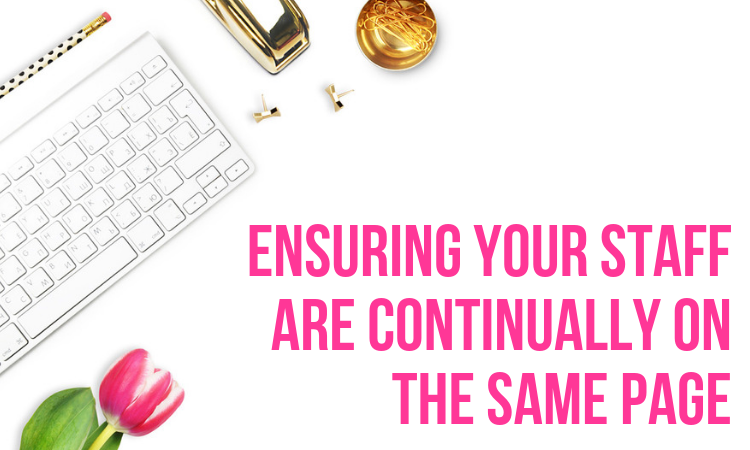Staff, no matter what tasks you acquire them for or what departments you decide to place them in, need to be on the same page. It is only in confidential matters of secrecy or in legal or lawful matters such as a police hierarchy where ‘for your eyes only’ and other secrets must be held from staff members. But even then, the framework in which these communications and same directions are delivered, supplied and routinely cared for can be more than worthwhile when they bring people together, not push them away.
This is a contributed post. Please refer to my disclosure for more information.
Ensuring your staff are continually on the same page is not something you try to achieve not only because it’s convenient, but because it helps you stop wasting time, it improves accountability, it allows synergy, and it can ultimately save you money in wasted effort and mistakes. But as there are many tasks that your employees must complete in a given day, there are many areas of your business in which it’s important to apply this ethos.

Let us explore that together:
Use The Same Digital Infrastructure
While file types are often utilitarian these days, there can be differences in how certain programs interface with those files and edit them. For example, a PDF is often just a PDF. But depending on if you open it with a paid version of Adobe Acrobat or a free PDF reader from computer to computer will lend yourself and your colleagues various different means of editing, signing and replicating the same file.
To that end, using the same programs to work is effective. For example, consider a team of graphic designers. If the lead designer uses Photoshop CC while the rest use the free program GIMP, then automatically there is a disconnect. The same digital infrastructure is important no matter what you’re using. From a VPN provider to a document creation tool to even a means of organizing file types, using one standardized format not only ensures you can isolate problems and train employees more quickly, but it also helps you communicate and think within the same framing each time.
Sometimes, you may have the advantage of allowing one entire service take care of all your IT needs. For example, Workplace 2.0 and Microsoft 365 offer a cohesive package through security to document creation and cloud hosting. This can even be more convenient, useful and secure than having disparate programs take care of different functionalities, or at least different programs crafted by different developers.
Linguo
Much like a family, close office relationships will often develop their own form of referrals in communication, and this creates a personal language or linguo that those ‘in the know’ will start to use for convenience. Perhaps the most obvious use of this is how the police force use codes to refer to certain crime scenes or sitrep reports, or how the military uses certain jargon to ensure that miscommunication is limited.
However, in those institutions that jargon has been explicitly chosen and understood, and often developed with that sense of clarity in mind. The same cannot be said, at least in a guaranteed sense, with the jargon espoused by your colleagues. Some of it might take hold in part of the office once a specialist is brought in, or perhaps you yourself have been a little too forthright with using this kind of coded language much to the confusion of your staff.
It’s important that everyone is on the same page. This means that if you are to use linguo, for security, proper categorization or the means of reducing miscommunication, you should train your staff on that. You should also give staff the means to understand the relevant terminology they need to use. For example, teaching your support staff the phonetic alphabet can ensure they take addresses, serial numbers and contact information correctly when on the phone with a customer.
Daily Briefings
Even the smallest change within the cycle of 24 hours can have a big impact on how the company functions and how able it is to meet demand. For this instance, a daily briefing in the morning can be a big boost. It might simply be a summary of the daily tasks and encouraging people to have a good day. It might be trying to better illustrate a problem that the staff need to work through now more information has come to light. Daily briefings offer a window into the direction you wish staff to take, and not only that, but it allows you to gain feedback from them. To this end, the staff engage in a dialogue, and after coming to conclusions you can make everyone quite clear as to what their responsibilities are.
Solid HR
Part of keeping staff on the same page is ensuring they want to communicate in the first place. If the office social scene is suffering, if arguments or disagreements are being vocalized in aggressive terms, or even if there’s the slightest presence of abuse (which should be stamped out immediately, of course,) your staff will likely begin to despise each other and it will show in their work.
For that reason, keeping tight control of your ship, stocking an impressive and confidential HR service and also rooting out any bad apples can ensure your office unit is as tight as needs be for effective communication.
Contact
Keeping the office in the loop might not be a task simply for the office meeting. A group chat of your employees, using apps like Slack for example, can ensure that you will speak to those under your charge with efficiency. And that a group conversation can be had. Here you can see who understood or even read your original message, and may help you all stay in the loop even if employees are off-site or on placement. To us, that sounds like a useful tool.
With these tips, you’re certain to ensure your office is continually on the same page.
What To Read Next
How To Create, Grow And Monetize A Brand New Instagram Account



